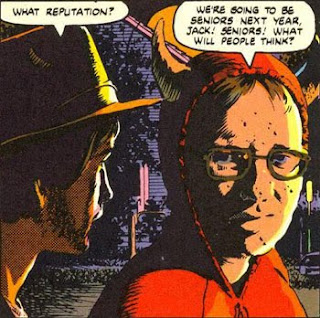Creepy, Issue #79Published May 1976, Warren Publishing
Painting by
Manuel Sanjulian
If someone made me answer what was
THE greatest 10 years in the history of horror, I would have to say 1968 to 1978.
The movies... 'Night of the Living Dead' in 1968 which resurrected the horror genre, and 'Rosemary's Baby' also 1968
'The Last House on The Left' 1972,
'The Exorcist' 1973,
'Black Christmas' and 'The Texas Chainsaw Massacre' 1974,
'Jaws' 1975,
'The Omen' 1976,
'The Hills Have Eyes' 1977,
'Dawn of The Dead' and 'Halloween' both in 1978.
Something very special happened in those years. If you look at all the titles (except 'Jaws'), the bad guys are, well, more or less, HUMAN. Living human dead who feast on the flesh of the living, demonically possessed human, to crazy human. Something has happened to us and we're BAD!
Oh yeah, Woodstock happened in 1969 as well. A very transitional 10 years. The fear of those who live outside our boundaries was replaced by a fear of those who live inside them. We have seen the enemy and it is ourselves. Well, for the most part anyway. Ridley Scott's 'Alien' was 1979.
For Horror Comics, these were
Fantastic years. DC's '
House of Mystery' returned to its scary themes in July 1968, captained by Joe Orlando. Its success would launch a new wave of mystery/scare titles for both of the Big Two. '
Creepy' and '
Eerie' were forerunners (due to their magazine format) with Creepy debuting in 1964. The first 'Eerie' magazine hit in 1966 and '
Vampirella' debuted in late 1969. And 1968 to 1978 were some of their best years.
Anyways, back to the cover...
You'll notice that 'Creepy'
doesn't have a large logo obscuring the top third of the art. It's actually just type with the focus on the artwork. Why is that?
1. Jim Warren paid these cover artists a lot of money.
2. Magazines weren't sold in spinner racks.
There's a bit of debate as to who actually did the cover to Creepy 79, Enrich Torres or Manuel Sanjulian. Both are amazing artists. The confusion is from the fact that Torres did an alternate cover to Creepy 79 that was never used. You can see it here.
And the winner is...
Manuel Sanjulian... You are brilliant. I'm upset that there is ANY type desecrating that gorgeous cover. The tag in the upper left-hand corner should have been enough. It's Creepy, issue 79, A Warren Magazine. Stick the $1.00 price tag underneath. Boom! Instant classic.
But this is the essence of great cover.
1. Why is this attractive woman clutching a severed hand?
2. Why is she (what appears to be) a mortuary?
3. Why is there FEAR in those dark, haunting eyes... She seems to be hiding... What could she be hiding from?...
oh crap.. what if that hand?.... oh.... jeez... no...
Really fires up the dark corners of the imagination, doesn't it? Fear of the unknown. We're given the setting and the mood and the tidbit of the severed hand, but no more. Mr. Hitchcock, you have taught us well.
Next Up, I think I'll discuss a work of the late Frank Frazetta.















